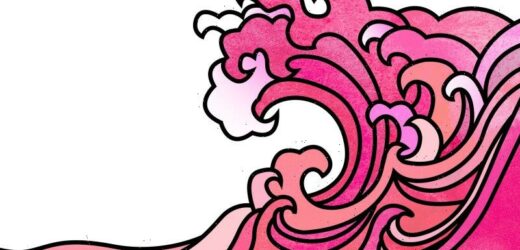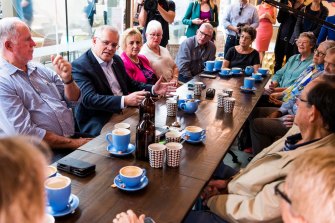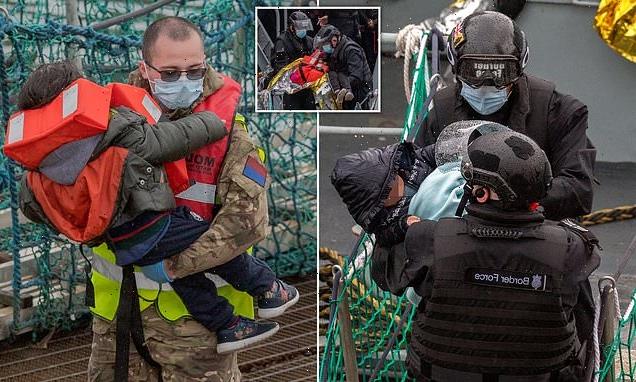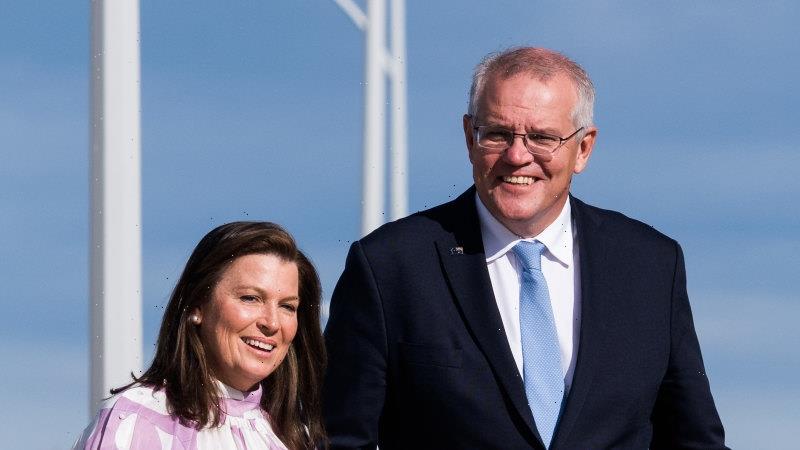Get ready for an identity shock. The Australian political system is about to break into three unpredictable parts, between Labor, the Liberal-National Coalition, and none of the above.
It is the only thing the major parties privately agree on at the end of a petulant campaign. Whoever forms the next federal government, whether in their own right or with the support of an enlarged crossbench, is expected to take office with a historically low primary vote. This will mean power without broad appeal for the winning side, while the loser faces an existential crisis, even if they fall only a few seats short of victory themselves.
The fear for both Labor and the Coalition is that their respective primary votes will remain stuck in the low to mid-30s, as the opinion polls have been warning since Scott Morrison called the election six weeks ago for May 21.
If this is indeed the case, it would also mean that the third-party vote – already at a postwar high of 24.7 per cent in 2019 – crosses 30 per cent for the first time. You have to go back to the earliest years of federation, when the Australian Labor Party was in its infancy and the right was split between the Protectionists and Free Traders, for an equivalent period of churn in our democracy.
A fractured electorate will confirm politically what we have known as citizens for some years, and have felt even more keenly since COVID-19 disrupted our lives. Australia is divided by gender, class and place – between women and men, young and old, the cities and the regions, and, within the capitals themselves, between the leafy inner suburbs and the urban fringes.
The fault lines first opened during the recession of the early 1990s, when unemployment undermined Labor’s blue-collar base in the cities while the Coalition’s conservative flank splintered in the regions. Those cracks have widened substantially over the past decade – even as our economy returns to full employment – because the traditional notions of who we are as a country have been challenged by workplaces and communities that no longer resemble the men who seek to govern us.
The single largest occupation group are female professionals. They overtook male technical and trade workers in 2015. The fastest-growing area of the labour market is the caring sector. Scott Morrison and Anthony Albanese are none of the above.
Every election acts as a check on our tribal prejudices. But this one, uniquely, offers so many competing versions of Australia that it can only be understood through the multiple ironies of the contest.
Leafy no-go zones
The first irony can be seen in the wealthiest and best-educated electorates in our two largest cities. The government faces a perfect cosmopolitan storm that begins in Melbourne’s golden mile along Brighton Beach in Goldstein, runs through the mansion belt of Toorak in Higgins and into Robert Menzies’ old middle-class heartland of Balwyn and Kew in Kooyong.
A pink wave of working women could sweep all before it at this election. Illustration: Richard GilibertoCredit:
A parallel front extends from east to north across Sydney, from its wealthiest harbourside suburb of Vaucluse in Wentworth, through North Sydney and into John Howard’s old seat of Bennelong. “Teal” independents threaten the Liberals in Goldstein, Kooyong, North Sydney and Wentworth, while Labor has its eyes on Higgins and Bennelong.
The defining feature of all these electorates, as well as Perth’s wealthiest seat of Curtin and two Liberal seats in Adelaide – Boothby and Sturt – is not just their places on the income and education ladders, but their gender. All have above-average shares of female voters, with Kooyong ranked highest of the group at 52.6 per cent – more than a percentage point above the national total of 51.2 per cent.
By his own admission, the prime minister wasn’t welcome here and would hurt his government’s chances if he embarked on a street walk with his Treasurer Josh Frydenberg in Kooyong.
The theory Morrison offered to Leigh Sales on the ABC’s 7.30 program this week was that these lifetime Liberal voters had moved beyond material concerns. “Many of these places, I suppose, are less vulnerable to the impacts of the economy than, say, many of the places I’ve been in this campaign,” he said.
It was a revealing comment because his 2019 pitch to “these places” was built around material concerns. The government scare campaign against Labor’s tax-and-spend agenda was designed to shore up the old class loyalty of voters who own property and shares. The bargain Morrison struck with them was to forgive the Coalition’s stalling on climate change because he would save their franking credits.
Intriguingly, one of the subplots in the 2022 campaign has been the appearance of past prime ministers John Howard and Kevin Rudd in the electorates that Morrison dare not set foot in. Perhaps the parties are trying to recreate the vibe of our last normal election, in 2007, when the contest was between leaders with high approval ratings and the main parties each had primary votes safely above 40 per cent.
The Liberals have followed up Howard’s campaign stops with a personalised letter which mentions the elephant in the mansion.
“Of course Scott Morrison has his critics and that’s part of the job,” the former prime minister wrote in his missive to voters in Higgins. “However, in these uncertain times, he and his Liberal team are the best choice to ensure a strong future for our wonderful country.”
Howard would recall that in 2007 the then member for Higgins, his treasurer Peter Costello, had removed any reference to the PM from his election material.
Divided by place
The second irony follows from the first, and it is in the majority that Anthony Albanese is chasing for Labor. Party polling has identified more than twice as many winnable seats in the capitals (14) as in the regions (six). When you consider the starting point for the campaign was 46 Labor seats in the capitals and just 23 in the regions, the opposition is relying on an electoral map that reinforces the fault line of place.
The Coalition holds 30 seats in the capitals, and 46 in the regions. The crossbench has the remaining six seats, three in each zone. Morrison has made it clear his goal is to offset any losses in the capitals to Labor or the teals with gains from Labor on the urban fringes and in the regions.
Campaigning outside Brisbane City Hall. The divide between capitals and regions, and between the inner cities and outer urban areas, has only sharpened.Credit:Tony Moore
How does a country divided along these lines actually function?
There is an unfortunate reflex in our politics – from those who practice it to those who analyse it for a living – to seek American or British analogies for our polarisation. But the better framework has always been to view Australia through the oldest lens of settlement, our colonial-era rivalries.
Australia’s decades of complacent prosperity in the 1950s and ’60s, and our reform decade of the 1980s, were exceptions to the rule of division between states.
Federal governments were anchored with majorities across Victoria, NSW and Queensland. In the 17 elections held between 1949 and 1987, the party that formed government won a majority of seats on 15 occasions in Victoria, 14 in NSW and 13 in Queensland. Elections were decided, in effect, in the middle-class suburbs of Melbourne and Sydney.
The early ’90s recession broke that run. In the 11 elections held since 1990, Queensland has sided with the winner on 10 occasions, NSW eight and Victoria just three times. The simple explanation is that Victoria turned leftward, while power shifted to the north.
But the story is more complex. Melbourne and Sydney had, in fact, been moving even closer politically – but apart from the rest of the nation.
An early indication of the new cosmopolitan bond was the 1999 republic referendum, where Victoria and NSW recorded above-average Yes votes, while Queensland returned the largest No vote.
Howard never won a majority of seats in Melbourne during his four election triumphs between 1996 and 2004, and always performed relatively worse in his hometown than he did in the rest of NSW and across Queensland.
That pattern has repeated over the course of the past three Coalition governments. Tony Abbott reclaimed office in 2013 without needing a majority in Victoria, while Malcolm Turnbull lost both Victoria and NSW in 2016, as did Morrison in his 2019 “miracle” win.
The key across all three terms that allowed the Coalition to retain power over a polarised country was their super-majorities in Queensland and Western Australia. The country was run by prime ministers from Sydney, but on behalf of the frontier states.
Turnbull and Morrison were each in their way hostage to the rifts within the Coalition party room. The Queenslanders always threatened to cross the floor against Turnbull, and ultimately led the rebellion which saw Morrison emerge as the compromise candidate over Turnbull’s challenger Peter Dutton.
Yet Morrison has been no more effective than Turnbull in managing the tensions between moderates and conservatives within the government. Part of this is due to the reform fight he chose to pick on religious discrimination. He simply never had the numbers.
From Sydney, for the frontier: Prime Minister Scott Morrison with Nationals MP Michelle Landry at the Rockhampton Museum of Art in the seat of Capricornia. Credit:James Brickwood
Recall the five moderates who crossed the floor to defeat that legislation in February – Katie Allen, Bridget Archer, Fiona Martin, Dave Sharma and Trent Zimmerman. Allen is the member for Higgins, Sharma represents Wentworth and Zimmerman North Sydney – three of the inner-city seats at risk from teal independents or Labor. Martin is the member for Reid in Sydney’s inner west, while Archer represents Bass, the ultra-marginal seat based around Launceston in Tasmania. Both are also on Labor’s target list.
To his credit, Morrison did secure Coalition agreement for a net zero emissions policy by 2050. But his effort to end climate change wars within the government has been undermined by the same conservative voices from Queensland that vetoed Turnbull on this issue.
Here’s the final irony, and it is in Morrison’s own persona as the curry-cooking, rugby league-following man of faith from the suburbs.
Splitting the difference
Nothing Morrison has done in politics has been subtle. He has the campaign director’s habit of letting the public know how he views the electoral map. The insight he had in 2019, when all the polls suggested he would lose, was that the Coalition could protect its majority by picking up seats from Labor in the regions when the tide was already going out on the Liberals in the capitals.
He drew that conclusion, in part, from the result of the Marriage Equality postal survey in 2017, which found Queensland and NSW to be slightly less progressive than the nation at large. Only 17 of the nation’s 151 electorates voted “no”.
Morrison took most notice of the 12 that rejected same-sex marriage in NSW. Among them were Bennelong, Parramatta and Gough Whitlam’s old seat of Werriwa, in Sydney’s outer south-west, where Morrison made an unexpected appearance on Thursday.
With Perth and even Brisbane threatening to swing to the left, thus joining the other capitals in the Labor column, the only realistic hope for the government’s re-election is a realignment that brings migrants and blue-collar workers from the urban fringes of Sydney into the Coalition’s waiting arms.
The problem with this pitch is that it seeks to make a virtue out of what may be the defining issue of the campaign: Morrison’s character. You may not like me, he seems to be saying, but I am more real than the other guy.
He makes no effort to bridge any of the divides in the electorate; on the contrary, he has revelled in them. Morrison presents himself as the everyman standing against cosmopolitan Australia.
The question is can a Liberal run against his own base in the city and survive, when the majority in those seats represents the biggest wave in Australian politics today: working women.
Cut through the noise of the federal election campaign with news, views and expert analysis from Jacqueline Maley. Sign up to our Australia Votes 2022 newsletter here.
Most Viewed in National
From our partners
Source: Read Full Article





